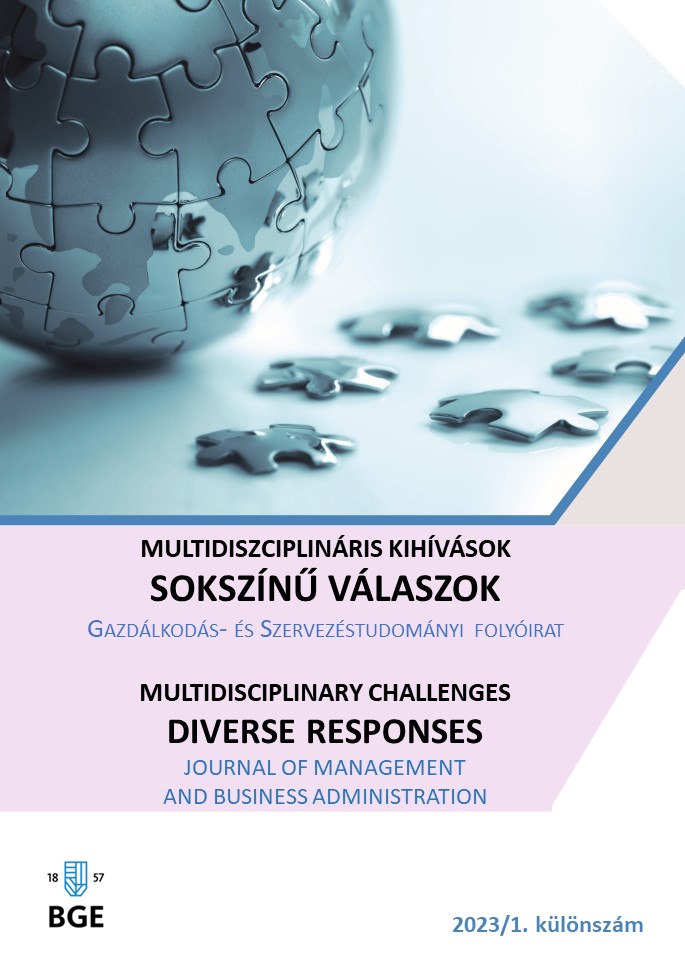Tradition and Innovation in the Community Spaces of City Hotels
Abstract
The conditions of accommodation management and hotel operation have changed significantly over the last two decades, the introduction and spread of innovation have resulted in the development of business models, which resulted in the radical transformation of the system and processes of hospitality and accommodation services.
Consumer habits, scenes of everyday life and workplaces have changed significantly, in response to the changing demand factors, tourism service facilities have also been transformed. Technological innovation has triggered unprecedented changes in service delivery processes, also tourism facilities have been extended with a range of new functions to meet the changing consumer needs. Communities have always played an important role in society, but the role of human interaction and personal relationships has never been more crucial than it is today, in the age of digitalization and social isolation.
The aim of the present study is to investigate the transformation of the service landscape in city hotels by using the literature review method. The exploratory research focuses on the interpretation of tradition preservation and introduction of innovation through the example of hotel community spaces.
References
Ahmad, H., Fazilah, F.M. & Suhardi, B.M., 2018. Public Preferences toward Shopping Mall Interior Landscape Design in Kuala Lumpur, Malaysia. Urban Forestry & Urban Greening, 30, 1–7. https://doi:10.1016/j.ufug.2017.12.019
Alfakhri, D., Harness, D., Nicholson, J. & Harness, T., 2018. The role of aesthetics and design in hotelscape: A phenomenological investigation of cosmopolitan consumers, Journal of Business Research, 85, 523-531. https://doi.org/10.1016/j.jbusres.2017.10.031
Alföldi, Gy., 2015. Habilitáció - Tanulmányok. Jövő városa – Budapest 2050. Budapest: Budapesti Műszaki és Gazdaságtudományi Egyetem, Építőművészeti Doktori Iskola.
Aubert-Gamet, V. & Cova, B., 1999. Servicescapes: From modern non-places to postmodern common places. Journal of Business Research, 44(1), 37-45. https://doi.org/10.1016/S0148-2963(97)00176-8
Baek, J. & Ok, C.M., 2017. The power of design: how does design affect consumers’ online hotel booking?, International Journal of Hospitality Management, 65, 1-10. https://doi.org/10.1016/j.ijhm.2017.05.001
Batista e Silva, F., Herrera, M.A.M., Rosina, K., Barranco, R.R., Freire, S. & Schiavina, M., 2018. Analysing spatiotemporal patterns of tourism in Europe at high-resolution with conventional and big data sources, Tourism Management, 68, 101-115. https://doi.org/10.1016/j.tourman.2018.02.020
Benkő, M., 2017. Zárt/nyitott – Városforma és térhasználat, Építés – Építészettudomány, 45(3-4), 327-339. https://doi.org/10.1556/096.2017.45.3-4.5
Berens, C., 1997. Hotel Bars and Lobbies, McGraw-Hill, NewYork.
Berger, V., 2016. Georg Simmel térelmélete(i), Szociológiai Szemle, 26(2), 4-28.
Berki, M., 2015. A térbeliség trialektikája, Tér és társadalom, 29(2), 3-18. https://doi:10.17649/TET.29.2.2658
Bitner, M.J., 1992. Servicescapes: The Impact of Physical Surroundings on Customers and Employees, Journal of Marketing, 56(2), 57-71. https://doi.org/10.1177/002224299205600205
Bollerey, F., 2012. Setting the stage for modernity –the cosmos of the hotel, In: Avermaete, T. & Massey, A., ed., 2012. Hotel Lobbies and Lounges, The Architecture of Professional Hospitality, Routledge, https://doi.org/10.4324/9780203137505
Cheng, J.S., Tang, T.W., Shih, H.Y. & Wang, T.C., 2016. Designing Lifestyle Hotels. International Journal of Hospitality Management, 58, 95-106. https://doi:10.1016/j. ijhm.2016.06.010
Clark, T. & Key, T.M., 2021. The methodologies of the marketing literature: Mechanics, uses and craft. AMS Review, 11(3), 416-431. https://doi.org/10.1007/S13162-021-00210-2
Collins, D., 2001. New Hotel: Architercture and Design, Conran Octopus.
Countryman, C.C. & Jang, S., 2006. The effects of atmospheric elements on customer impression: the case of hotel lobbies, International Journal of Contemporary Hospitality Management, 18(7), 534-545. https://doi.org/10.1108/09596110610702968
Curtis, E., 2001. Hotel Interior Structures, Wiley-Academy: London.
D’Souza, C., Apaolaza, V., Hartmann, P. & Brouwer, A.R., 2021. Marketing for Sustainability: Travellers’ Intentions to Stay in Green Hotels. Journal of Vacation Marketing, 27(2), 187–202. https://doi.org/10.1177/1356766720975063
Dewiyana, E., Ibrahim, N. & Hajar, N. H., 2016. The Green Aspects of Adaptive Reuse of Hotel Penaga, Procedia, Social and Behavioural Sciences, 222, 631-643. https://doi.org/10.1016/j.sbspro.2016.05.220
Dixon, G.R. & Aldous, D.E., 2014. An Introductory Perspective to Horticulture: Plants for People and Places, Volume 1. In Horticulture: Plants for People and Places, edited by G. R. Dixon and D. E. Aldous, 1–25. New Delhi: Springer Netherlands
Doğan, H., Nebioğlu, O., Aydın, O. & Doğan, I., 2013. Architectural innovations are competitive advantage for hotels in tourism industry? What customers, managers and employees think about it?. Procedia-social and behavioral sciences, 99, 701-710. https://doi.org/10.1016/j.sbspro.2013.10.541
Durst, C.S., 2018. Defining the 2019 hotel lobby. Lodging Magazine. [online] https://lodgingmagazine.com/defining-the-2019-hotel-lobby/ (2023.01.12.)
Emontspool, J. & Woodward, I., 2018. Cosmopolitanism, Markets and Consumption: A Critical Global Perspective. Palgrave Macmillan, London.
Enyedi, Gy., 2012. Városi világ, Budapest, Magyarország, Akadémiai Kiadó.
Gao, S., Jin, R., & Lu., W., 2019. Design for Manufacture and Assembly in Construction: A Review. Building Research & Information, 48(5), 538-550. https://doi.org/10.1080/09613218.2019.1660608
Generalova, E.M., Generalov, V.P. & Kuznetsova, A.A., 2016. Modular Buildings in Modern Construction. Procedia Engineering, 153, 167-172. https://doi.org/10.1016/j.proeng.2016.08.098
Glaeser, E., 2020. A város diadala, Pallas Athéné Könyvkiadó, Budapest.
Hays, D. & Ozretić-Došen, D., 2014. Greening Hotels - Building Green Values into Hotel Services, Tourism and Hospitality Management, 20(1), 85-102. https://doi.org/10.20867/thm.20.1.7
Han, H., Moon, H. & Kim, W., 2019. The influence of international tourists’ self-image congruity with a shopping place on their shopping experiences. Journal of Hospitality and Tourism Management, 41, 101-109. https://doi.org/10.1016/j.jhtm.2019.08.003
Heesup, H. & Sunghyup, S. H., 2019. Green Indoor and Outdoor Environment as Nature-based Solution and Its Role in Increasing Customer/employee Mental Health, Well-being, and Loyalty, Business Strategy and the Environment, 28(4), 629–641. https://doi.org/10.1002/bse.2269
Heide, M., Lærdal, K. & Grønhaug, K., 2007., The design and management of ambience—Implications for hotel architecture and service, Tourism Management, 28(5), 1315-1325. https://doi.org/10.1016/j.tourman.2007.01.011
Hory, G., Major, Z., Müllner, P. & Benkő, M., 2017. Exploration of spatial design issues at backpacker hostels in Budapest׳s historic center: Informality, density, and adaptability, Frontiers of Architectural Research, 6(2), 157-168. https://doi.org/10.1016/j.foar.2017.02.005
Huang, H. & Tsaih, L.S., 2022. Prioritizing hotel lobby design factors: perspectives of hotel operators in China, Journal of Asian Architecture and Building Engineering, https://doi.org/10.1080/13467581.2021.1966016
Juhász-Dóra, K., 2017. Analysis of additional hotel services in the international luxury hotels – a case-study from Budapest, Proceedings of the International Conference on Business Excellence, 11(1), 884-892. https://doi.org/10.1515/picbe-2017-0094
Juhász-Dóra, K., 2020. Vendégtér-paradoxon: Budapesti luxusszállodák miliője a helyi társadalom szemszögéből [Paradox of Guest Space : Milieu of luxury hotels in Budapest from the perspective of local society] 190 p., Doktori disszertáció.
Juhász-Dóra, K., 2022. A luxusszállodai miliő transzformációjának időbeli dimenziói. Turizmus Bulletin, 22(1), 13-25. https://doi.org/10.14267/TURBULL.2022v22n1.2
Juhász-Dóra, K. & Ilyés, N., 2023. A designmódszerek mint innovációs katalizátorok alkalmazása a szállodákban. Turizmus Bulletin, 23(1), 25-33. https://doi.org/10.14267/TURBULL.2023v23n1.3
Keller, L.A. & Burke, J., 2016. The financial impact of hotel renovations. Hotel Online. [online] https://www.hospitalitynet.org/opinion/4079832.html (2022.09.10.)
Kellert, S. & Calabrese, E., (2015). The practice of biophilic design. https://www.biophilic-design.com/
Kovács, I., 2009. A szálloda, mint termék, In: Papp Ilona, ed., 2009. Szálloda- és vendéglátásmenedzsment. Budapest: Akadémiai Kiadó.
Kramer, D. & Lutz, R., 1992. Resisen und Alltag, Beiträge zur kulturwissenschaftlichen Tourismus-Forschung, Traveling and Everyday Life: Contributions to Tourism Cultural Studies, Frankfurt.
Lai, J. H. K., 2016. Energy Use and Maintenance Costs of Upmarket Hotels. International Journal of Hospitality Management, 56, 33-43. https://doi:10.1016/j.ijhm.2016.04.011
Lee, S. H., 2019. Effects of biophilic design on consumer responses in the lodging industry. International Journal of Hospitality Management, 83, 141-150.
Lin, I. Y., 2016. Effects of Visual Servicescape Aesthetics Comprehension and Appreciation on Consumer Experience. Journal of Services Marketing, 30(7), 692-712. https://doi:10.1108/JSM-08-2015-0258
McNeill, D., 2008. The hotel and the city, Progress in Human Geography, 32(3), 383-398. https://doi.org/10.1177/0309132508089096
Michalkó, G., 2023. A turizmus esszenciája. Akadémiai Kiadó. [online] https://mersz.hu/michalko-a-turizmus-esszenciaja-uj/
Mundy, J., 2008. Wide Open Spaces. Hotelier. 20(6), 44-46.
Nanu, L., Ali, F., Berezina, K. & Cobanoglu, C., 2020. The effect of hotel lobby design on booking intentions: An intergenerational examination, International Journal of Hospitality Management, (89) 102530 https://doi.org/10.1016/j.ijhm.2020.102530
Naqshbandi, D.M. & Munir, R., 2011. Atmospheric elements and personality: Impact on hotel lobby impressions. World Applied Sciences Journal, 15(6), 785-792. https://doi.org/10.2139/ssrn.2361143
Oldenburg, R., 1989. The Great Good Place. New York: Marlowe & Company.
Ong, C.E., Minca, C. & Felder, M., 2015. The Historic Hotel as ‘Quasi-freedom Machine: Negotiating Utopian Visions and Dark Histories at Amsterdam’s Lloyd Hotel and Cultural Embassy, Journal of Heritage Tourism, 10(2), 167-183. https://doi.org/10.1080/1743873X.2014.985223
Patriotta, G., 2020. Writing Impactful Review Articles, Journal of Management Studies, 57(6), 1272-1276. https://doi.org/10.1111/joms.12608
Paul, J. & Criado, A.R., 2020. The art of writing literature review: What do we know and what do we need to know?, International Business Review, 29(4), 101717 https://doi.org/10.1016/j.ibusrev.2020.101717
Paul, J., Khatri, P. & Duggal, H.K., 2023. Frameworks for developing impactful systematic literature reviews and theory building: What, Why and How?, Journal of Decision Systems, https://doi.org/10.1080/12460125.2023.2197700
Post, C., Sarala, R., Gatrell, C. & Prescott, J. E., 2020. Advancing theory with review articles. Journal of Management Studies, 57, 351–76. https://doi.org/10.1111/joms.12549
Ryu, K. & Jang, S., 2008. Dinescape: a scale for customers’ perception of dining environments, Journal of Foodservice Business Research, 11(1), 2-22. https://doi.org/10.1080/15378020801926551
Sarmah, B., Kamboj, S. & Rahman, Z., 2017. Co-creation in hotel service innovation using smart phone apps: an empirical study, International Journal of Contemporary Hospitality Management, Volume 29 Issue 10, 2647- 2667.
Shi, J.Y. & Wang, Y., 2013. On Green Interior Design. Advanced Materials Research, 838-841, 2842–2845. https://doi.org/10.4028/amr.838-841.2842
Simmel, G., 1949. The Sociology of Sociability, American Journal of Psychology, 55, 254-261. https://doi.org/10.1086/220534
Song, C., Ali, F., Cobanoglu, C., Nanu, L. & Lee, S. H. J., 2022. The effect of biophilic design on customer's subjective well-being in the hotel lobbies, Journal of Hospitality and Tourism Management, 52, 264-274. https://doi.org/10.1016/j.jhtm.2022.07.008
Timothy, D. J. & Gelbman, A., 2015. Tourist Lodging, Spatial Relations and the Cultural Heritage of Borderlands. Journal of Heritage Tourism, 10(2), 202-212. https://doi:10.1080/1743873X.2014.985227
Vargas, G., Lawrence, R. & Stevenson, F., 2017. The Role of Lobbies: Short-term Thermal Transitions. Building Research & Information, 45(7), 759-782. https://doi:10.1080/09613218.2017.1304095
Walls, A., Okumus, F. & Wang, Y.C., 2011. Understanding the Consumer Experience: An Exploratory Study of Luxury Hotels. Journal of Hospitality Marketing and Management, 22(2), 166-197. http://dx.doi.org/10.1080/19368623.2011.536074
Wu, L., Liu, P. & Le, D., 2023. The role of public space in constructing experience capital: A longitudinal analysis in the hotel context, Tourism Management, 97, 104735, https://doi.org/10.1016/j.tourman.2023.104735
Wuni, I. Y. & Shen, G.Q., 2019. Critical Success Factors for Modular Integrated Construction Projects: A Review, Building Research & Information, 48, 763-784. https://doi:10.1080/09613218.2019.1669009
Xie, P. F. & Shi., W. L., 2019. Authenticating a Heritage Hotel: Co-creating a New Identity. Journal of Heritage Tourism, 14(1), 67-80. https://doi.org/10.1080/1743873X.2018.1465062
Zeithaml, V. A., Bitner, M. J. & Gremler, D. D., 2006. Services Marketing: Integrating Customer Focus across the Firm. Boston, MA: McGraw-Hill/Irwin.
Zemke, D.M.V., Chen, Y.S., Raab, C. & Zhong, Y., 2017. Hotel design, guest satisfaction, and behavioural intentions. Anatolia, 28(3), 338-350. https://doi.org/10.1080/13032917.2017.1319868
FELHASZNÁLT INTERNETES FORRÁSOK:
Allister, E., 2017. Millennial by Design: How Millennials Tastes are Shaping Hotel Design. [online] https://www.hoteliermagazine.com/millennial-design-millennial-tastes-shaping-hotel-design/ (2023. 01. 22.)
Bartlett, I., 2022. Workplace Trends: Reinventing the Office Lobby [online] https://www.workdesign.com/2022/01/2022-workplace-trends-reinventing-the-office-lobby/ (2023. 01. 22.)
Kilburn, H., 2018. Spotlight on: Storytelling in the Hotel Lobby. [online] https://hoteldesigns.net (2022.09.10.)
La Mamounia, 2023. La Mamounia Marrakech. [online] https://mamounia.com/en/ (2023. 01. 22.)
Loveexploring.com, 2023. The world’s most beautiful Hotel Lobbies. [online] https://www.loveexploring.com/galleries/68429/the-coolest-hotel-lobbies-in-the-world?page=1 (2023. 01. 22)
Manley, B., 2018. Hotel owners focus renovations on public spaces. Hotel News Now. [online] https://www.costar.com/article/2010011461/hotel-owners-focus-renovations-on-public-spaces (2023.01.22.)
Oey, D., Bruggen, M. V. & Hoogendoon, E., 2018. Coworking Hotels Industry Report, Horwath HTL, Hotel, Tourism and Leisure. https://www.hotelnewsresource.com/pdf18/HHTL_112618.pdf?utm_source=HTrends&utm_medium=referral&utm_campaign=HTrends-Publish (2023. 01. 22.)
Sirhotels, 2023. Sir Adam Hotel North. [online] https://www.sirhotels.com/en/adam/ (2023. 01. 22.)
Turizmus.com, 2022. Megsemmisült Berlin egymillió literes akváriuma. [online], https://turizmus.com/szallashely-vendeglatas/megsemmisult-berlin-egymillio-literes-akvariuma-1184500 (2023. 01. 22.)


























